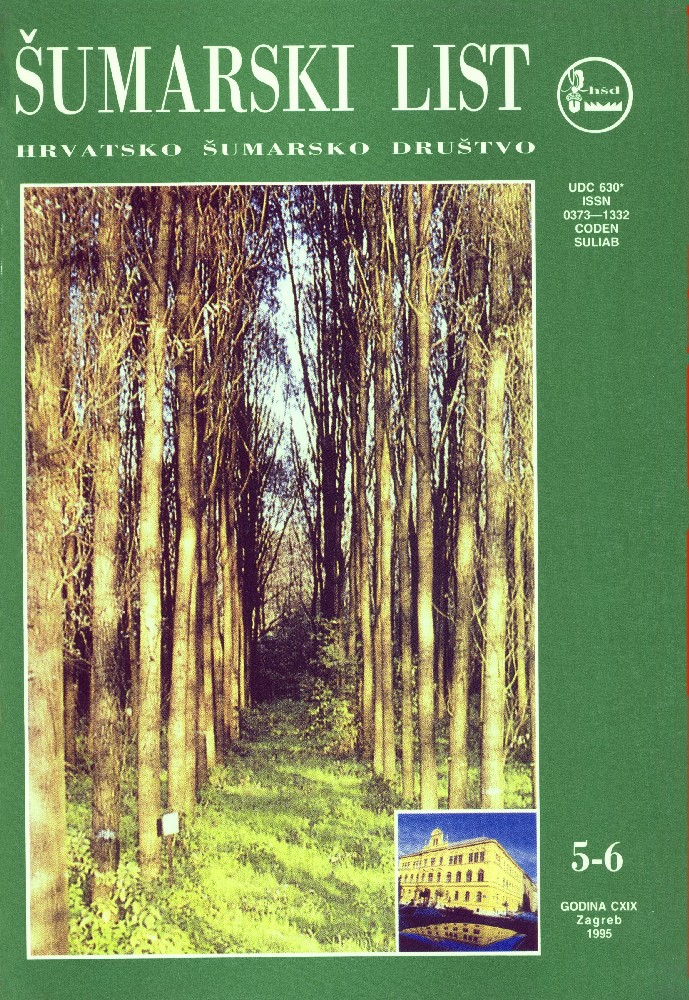
broj: 5-6/1995
pdf (13,5 MB) |
|
||||||||||||||
| IZVORNI ZNANSTVENI ČLANCI | ||
| Krstinić, A., Kajba, D. | UDK 630*232.275.2 (Salix sp.) | |
| First Results of Arborescent Willow Improvement by Seifing, Back Cross and Transgression pdf HR EN | 163 | |
| Komlenović, N., Orlić, S., Rastovski, P. | UDK 630*232.564 (Coniferae sp.) | |
| Growth and Biomass Production of Six Coniferous Species in Fern and Heath Areas of Croatia pdf HR EN | 169 | |
| Summary: The research was carried out trough a comparative experiment on domestic an foreign coniferous species. The locality was Lokve, a fern and heath area in the Forest district of Duga Resa, Forest Enterprise of Karlovac. Geographically it is 45° 26´ north latitude, 15" 18´ east longitude, 196 m above sea level. The climate of the research area is perhumid. According to Mayer, the soil has been defined as two-layer profile with distric cambisol on relict red soil. The research encompassed the economically most interesting coniferous species: Norway spruce (NS), Scots pine (SP), Austrian pine The used seed material for thr experiment is of known origin. The experiment started in the Spring of 1969. A three repetition randomized block system was applied. Planting spacing was 2 x 2 m (2.500 N/ha). The last measuring was done in the Autumn 1991, i. e. 23 years after the beginng of the experiment. Measured were the heights and breast -height diameters, and the survival rate of the plants was recorded. For determining the biomass produced per area unit, the felled mean stand tress were also selected per experiment replication. The fresh matter weight of trunks, stumps roots and branches, both live and dry, were established on site. The samples were dried at 105° C until constant weight was obtained, then minced and analyzed. A high percentage of survival was established with the Norway spruce (96.1 %), White pine (89.8 %) and Scots pine (81.5 %); Douglas fir (54.0 %), Austrian pine (57.0 %) and the European larch (59.0 %) demonstrated a poor capability to survive. The European larch and White pine are the leading two species regarding the height and diameter growth. The White pine produced the biggest, Austrian pine the smalles biomass. The European larch dry matter contains the larges quantities of all analyzed nutrients with the exception of calcium. The fewest nutrients were accumulated by the Austrian pine. In the larch and pines biomas there was the most nitrogen, while the spruce biomass contained the highest quantity of calcium. The wood of all tested species was relatively poor in nutrients which are abundantly found in the needles and bark. Nitrogen, phosphorus and potassium concentransions were higher in one-year-old needles, while in older ones there were found high calcium concentrations. According to stemwood production the efficency of the consumed nutrients was the highest with the White pine, the lowest with the Douglas fir. Key words: coniferous species, growth, biomass production, accumulation of nutrients in the biomass. Key words: coniferous species; growth; biomass production; accumulation of nutrients in the biomass | ||
| PRETHODNO PRIOPĆENJE | ||
| Šajković, A. | UDK 630*301.085(497.13) | |
| Forestry Students´Attitudes Toward Development and Protection of Environment pdf HR EN | 179 | |
| STRUČNI ČLANCI | ||
| Stojković, M. | UDK 630*442 (Ulmus minor Mill.) (497.13) | |
| Pershing of Elm Field (Ulmus minor Mill., sin. Ulmus carpinifolia Suckow) in the ex-Prigorje Zagorje Region pdf HR EN | 183 | |
| Piškorić, O. | UDK 630*902(497.13) | |
| The Hundredth Anniversary of the Laws on Forest Management of Croatia pdf HR EN | 189 | |
| Tonković, D. | UDK 630*902(497.13) | |
| Štirovača as a Former Centre for Wood Conversion of Central Velebit pdf HR EN | 201 | |
| Starčević, T. | UDK 630*95 | |
| Statute on Forest Management. To Implement or to Change? PDF | 207 | |


